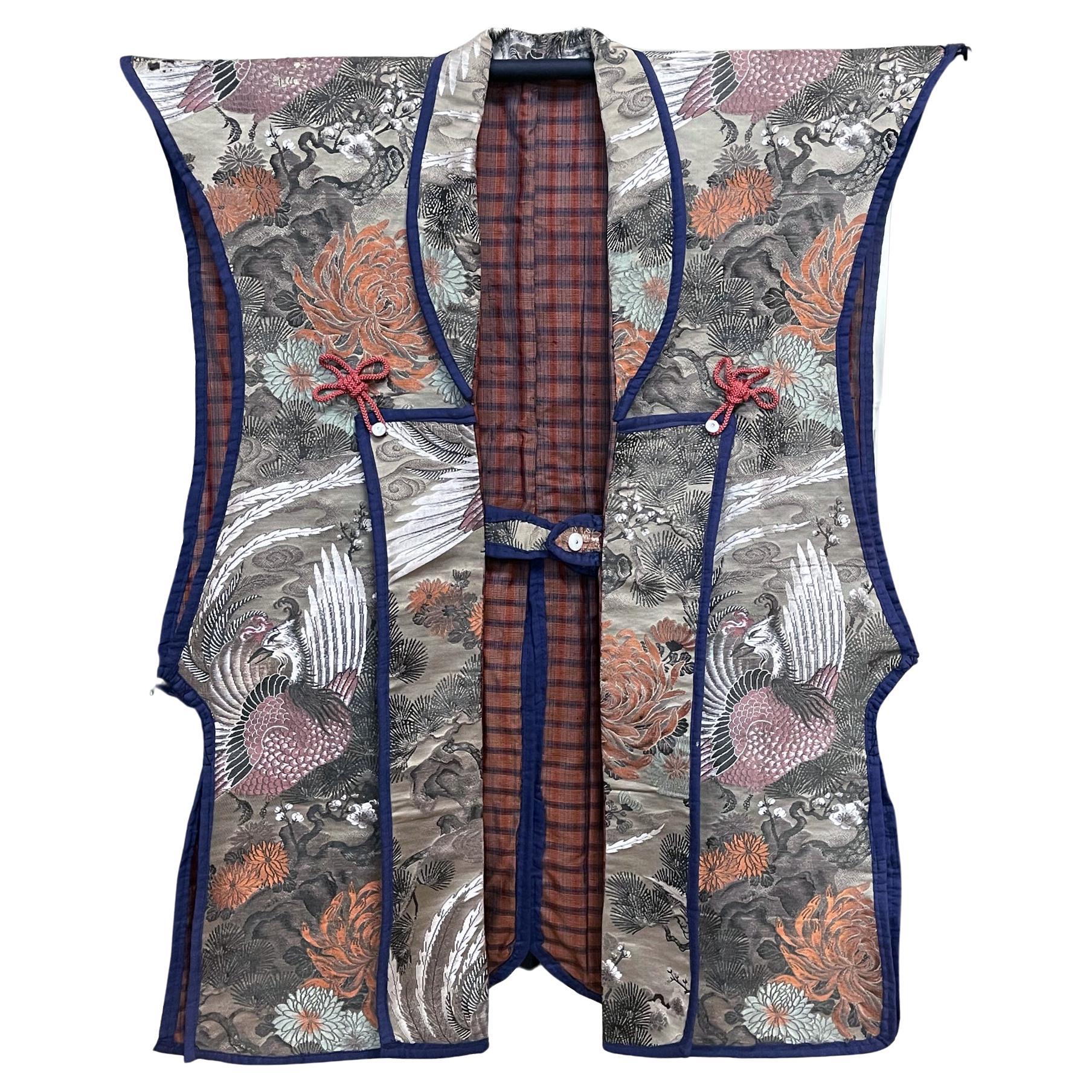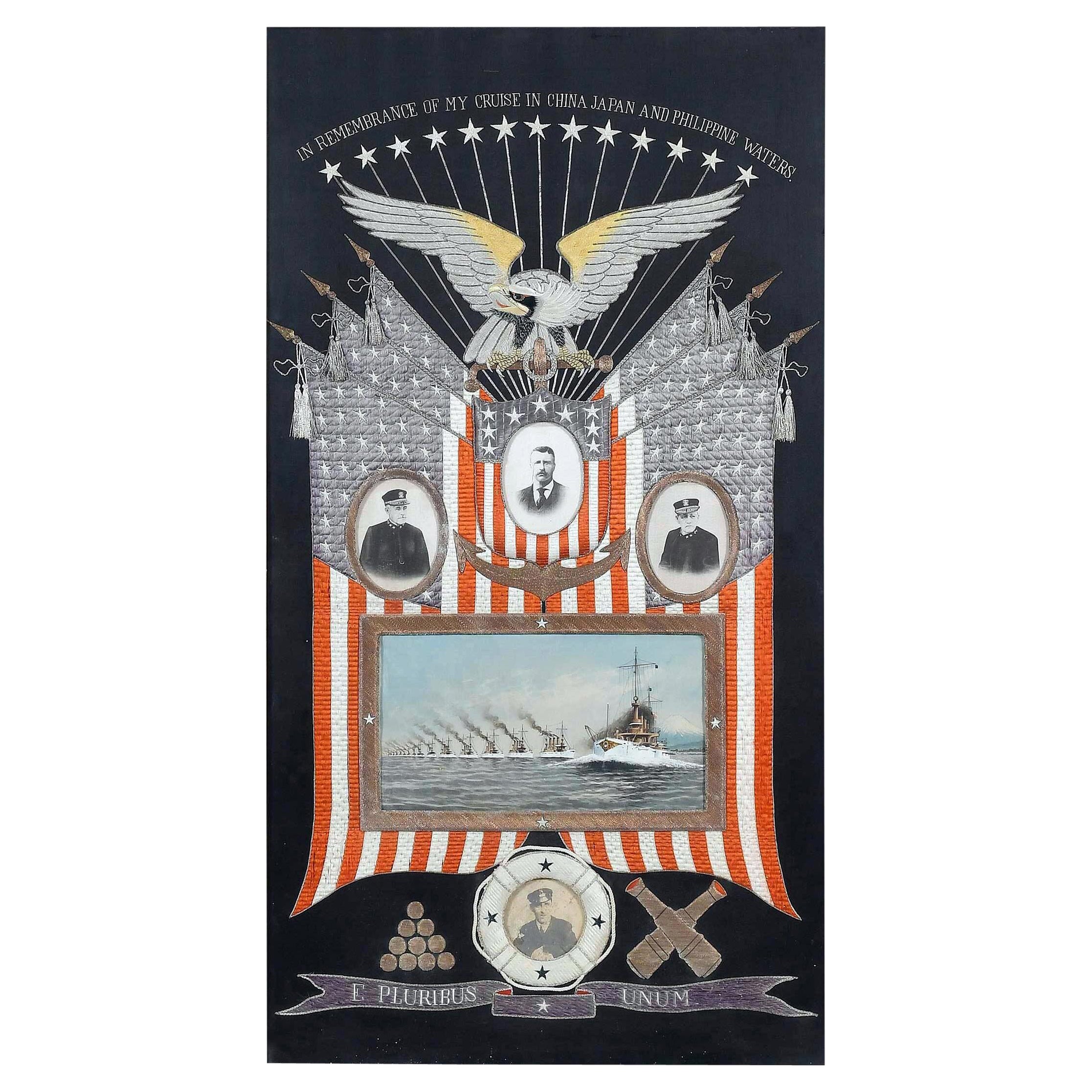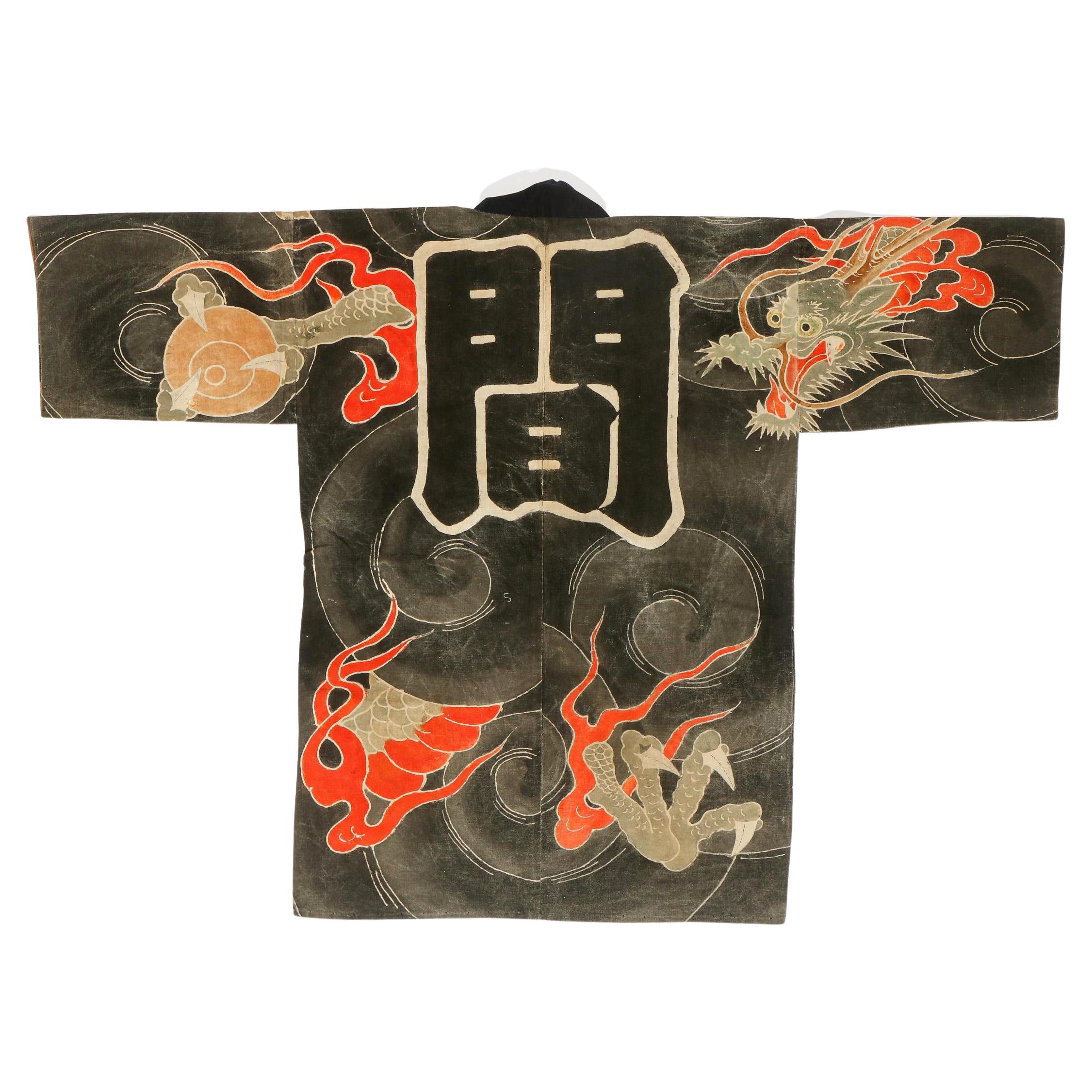Items Similar to Antique Japanese Textile Art Campaign Jacket Jinbaori with Mon
Want more images or videos?
Request additional images or videos from the seller
1 of 10
Antique Japanese Textile Art Campaign Jacket Jinbaori with Mon
About the Item
Known as Jinabori during 16th century when warfare was common in feudal Japan, the sleeveless jacket was created to be worn outside of the armor by samurai warriors. In addition to serving as a further protection while allowing free movement, the bright color and the family crest (mon) on the back also function as a visual identification of the clan and rank of the wearer. In Edo period, when the society was stabilized, these types of the jackets gradually shifted toward ceremonial function from the battlefield. Made of expensive material such as fine wool, linen for the exterior and elaborate silk brocade (kinran) for the flap and interior lining, this rare and well preserved Jinabori on offer adhered to the classic vest form with front lapel that can flap open or close fastened by MOP buttons, a tie on the front with matching button and a high slit on the back. The placement of the two shoulder bands on top of the façade instead of directly above the shoulder suggests that it was made for ceremonial use consistent with its age (late Endo period circa 19th century). The back features a Hanabishi mon (Diamond-shape flower) as an identification crest for the clan.
The jacket is not framed and can be framed or displayed on a hanging rod as one wishes.
For reference and analysis on two similar Jinabori, see page 302-305 of "A New Yorker's View of the World The John C. Weber Collection.
- Dimensions:Height: 42 in (106.68 cm)Width: 25 in (63.5 cm)Depth: 0.2 in (5.08 mm)
- Style:Japonisme (Of the Period)
- Materials and Techniques:
- Place of Origin:
- Period:
- Date of Manufacture:19th Century
- Condition:Wear consistent with age and use. Fine antique textile condition, a few scattered punctures on the red wool layer, around neck and the breast tie. The largest one on the lower right is about 0.2 inch in diameter which is visible on the detail photos.
- Seller Location:Atlanta, GA
- Reference Number:1stDibs: LU945022838032
About the Seller
5.0
Platinum Seller
These expertly vetted sellers are 1stDibs' most experienced sellers and are rated highest by our customers.
Established in 2006
1stDibs seller since 2010
480 sales on 1stDibs
Typical response time: <1 hour
- ShippingRetrieving quote...Ships From: Atlanta, GA
- Return PolicyA return for this item may be initiated within 2 days of delivery.
More From This SellerView All
- Japanese Ceremonial Brocade Jinbaori Vest JacketLocated in Atlanta, GAMade entirely from luxuriant woven brocade (kinran) for the exterior, this Japanese sleeveless jacket is called Jinbaori. Commonly worn by the Samurai warriors during 16th century when warfare was common in feudal Japan, this type of loose jacket, as a surcoat on top the armor, served as an extra protection, and more importantly as an identification in the battlefield with its bright colors and often Mons. In Edo period, the society was stabilized and Jinbaori gradually shifted toward a pure ceremonial function. The jacket on offer was unusual as it was tailored entirely from the bright Chinese brocade...Category
Antique 19th Century Japanese Meiji Textiles
MaterialsSilk, Brocade
- Framed Japanese Fukusa Textile Art Meiji PeriodLocated in Atlanta, GAA Japanese Fukusa textile panel circa late 19th-early 20th century of Meiji Period. On the woven brocade background with gold thread forming clouds and...Category
Antique Late 19th Century Japanese Japonisme Textiles
MaterialsSilk, Giltwood
- Framed Japanese Relief Embroidery Textile Art of DragonLocated in Atlanta, GAA beautiful Japanese textile art panel with an embroidered dragon on a swirling cloud background, nicely framed with a linen matt in an antique-fi...Category
Antique 1890s Japanese Japonisme Textiles
MaterialsSilk, Wood
- Japanese Fukusa Relief Embroidery Textile Art of DragonLocated in Atlanta, GAA visually stunning Japanese fukusa panel with an embroidered dragon on a swirling cloud background, nicely displayed on a scarlet felt matt in a carve...Category
Antique 1890s Japanese Japonisme Textiles
MaterialsSilk, Wood
- Japanese Antique Textile Panel of American Historical Great White FleetLocated in Atlanta, GANicknamed Great White Fleet, the sailing of the United States Navy battleships around the globe from December 16, 1907 to February 22, 1909 by order of Uni...Category
Antique Early 1900s Japanese Japonisme Textiles
MaterialsBrocade, Silk, Wood
- Antique Japanese Shirushi-Banten Fireman Jacket Edo PeriodLocated in Atlanta, GAA Japanese Shirushi-Banten (Fireman's Coat) circa 19th century of Edo Period. The robe was made from a heavy cotton fiber and decorated with a dramatic dragon in the dark cloud scheme using Tsutsugaki, a free-hand resist dye method. A dragon with claws clenching pearls and red-orange fire motifs was artistically depicted slithering in and out of dark swirling clouds from the front to the back of the robe. The spatial composition was superb as well as the stylized motion. The indigo blue colored neck lapel bears scription indicating the location of where the robe belonged: the Kannon-Ji of Magino District (The Temple of Kannon; In Japan, the goddess of mercy Guanyin was known as Kannon). This temple is located in Higashine City of Yamagata Prefecture in Northern Japan. On the back, there is a large Kanji Character "Space" in the center, matching the first symbol of the location "Magino" in the front. It is likely that instead of a functional fire-fighting gear, the robe was used in festival parade by firemen, perhaps sponsored by the temple for the town event. When fully extended as shown in photo 1 and 2, it measures 50" W x 37" H. A beautiful and well-preserved sample of Japanese textile art.Category
Antique 19th Century Japanese Japonisme Textiles
MaterialsTextile
You May Also Like
- Vintage Japanese Indigo Folk Kamon TextileLocated in Chicago, ILDating to the mid-20th century, this vintage Japanese textile is a folk example of traditional stencil dyed fabric, known as katazome. Richly...Category
Mid-20th Century Japanese Textiles
MaterialsCotton
- Vintage Japanese Indigo Folk Kamon TextileLocated in Chicago, ILDating to the mid-20th century, this vintage Japanese textile is a folk example of traditional stencil dyed fabric, known as katazome. Richly...Category
Mid-20th Century Japanese Textiles
MaterialsCotton
- Framed Antique Chinese TextileLocated in Delray Beach, FLA spectacular antique Chinese embroidery panel dated from (circa 19th century), professionally framed with linen mat, purchased from A...Category
Antique 19th Century Chinese Tapestries
MaterialsSilk, Bamboo
- Antique Silk Bokara Ikat TextileLocated in Alessandria, PiemonteVery antique Central Asia silk Ikat, backed on original linen, suitable for wall, bed, table. Particular design, part of my personal collection. (Interesting price for closing activi...Category
Antique Late 19th Century Turkmen Other Tapestries
MaterialsSilk
- Japanese Indigo Antique Boro Futon Cover or Wall PanelLocated in Alessandria, PiemonteRare perfect antique collection Japanese Indigo Boro Futon cover : also to use. The rare antique boros are now valued as pieces of art, therefore they are...Category
Mid-20th Century Japanese Japonisme Textiles
MaterialsCotton
- Late 19th Century Japanese Stencil-Dyed Textile / Kumano-zomeLocated in Point Richmond, CALate 19th Century Japanese Stencil-Dyed Textile / Kumano-zome This 2-panel cotton textile was made in the Kumano region of Okayama Prefecture in th...Category
Antique Late 19th Century Japanese Meiji Textiles
MaterialsCotton





